Eisejuaz: shamanism and cevil
(fragment)
DOI:
https://doi.org/10.15174/rv.v13i28.601Abstract
Abstract: This work is a fragment of a book in preparation: Eisejuaz,chamán. Gérmenes y materiales. It addresses the novel Eisejuaz, by Sara Gallardo, few knowed until a few years ago and a marginal masterpiece that immerses itself in the universe and speech of the Wichí people, through its protagonist, Eisejuaz —imaginary or fictional, but in its origin very real— , whose links with ancient shamanism were not entirely dissociated from the actions of the so-called “Shamans of God”, and above all —through the figure of Santos Aparicio, or “Vicente Aparicio” in the novel—, with the intervention of cebil, the “hallucinogenic” plant.
Published
How to Cite
Issue
Section
License
Author(s) who publish in this journal do accept the next conditions:
According to copyright regulations, Valenciana does recognize and respect the authors’ moral right, as well as the right of property, which will be assigned to the journal for its diffusion in open access.
Valenciana does not charge authors for the submission, editorial process or publication in the journal.
All texts published and distributed by Valenciana (without exception) are supported by the license Creative Commons Attribution-NonCommercial 4.0 International (CC BY-NC 4.0), which allows third parties to use the publication as long as they mention the author and the first publication.
Authors can make other independent and additional contractual agreements for the non-exclusive use of his article published in Valenciana (e.g. including it in an institutional repository or in printed/electronic media), as long as it is explicitly clarified that the article was published for the first time in this journal.
For these purposes, authors must sign and send the letter of submission and copyright transfer form in a PDF file to this email address: revistavalenciana@gmail.com
This journal is under a license by Creative Commons Atribución-NoComercial-SinDerivadas 4.0 Internacional (CC BY-NC-ND 4.0)).











